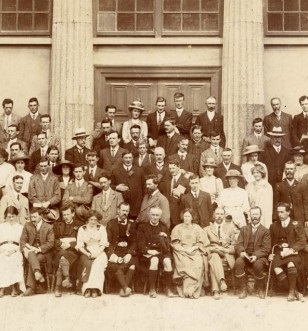Old Galway
BUNSCOIL STUDENTS IN THE JES, 1963 (15 05 14)

In 1962, the Jesuit community in Sea Road celebrated the centenary of their school, and the following year, they celebrated the centenary of the Church of St. Ignatius. Eamonn De Valera, who was President of Ireland at the time, attended the church celebrations, and our photograph today shows some of the students of the Bun-Scoil applauding his arrival.
THE DEVON PARK UNDER-14 TEAM, 1967 (08 05 14)

The great strength of the Gaelic Athletic Association is that it has spread into virtually every street and small village in the country. Having players and supporters all over Ireland has made this organisation one of the most popular and one of the most powerful in the land.
CALLING ALL JES BOYS AND GIRLS (01 05 14)

There is historical evidence to show that there were Jesuits working in Galway in the early 1600’s. Even before that, men from the west of Ireland were entering the Jesuits which indicates that their reputation had arrived here very shortly after the Order was founded. They had a chequered history here (as they had in the rest of the country) in that they were banished several times, but they kept coming back.
EAMONN CORBETT AND 1916 (24 04 14)

Eamonn Corbett came from Kileeneenbeg near Clarinbridge. He was associated with the Volunteer movement in County Galway from 1914 onwards. After the Redmondite split he gave valuable assistance in organizing the Volunteers throughout the County, and in 1915 he was assisting Liam Mellows while training the various companies in the Brigade area.
SATURDAY IN THE MARKETPLACE, 1948 (02 01 14)

“Let not the visitor miss the joyful chaos of Galway’s week-end purchasing. Saturday is not a day of speed. Petrol must give way to horsepower and donkey-power, and cattle that like to investigate both sides of a road. Proud, glittering models of fame crawl humiliatingly in face of a stream of vehicles of astonishing build and variety, rumbling in from Connemara. Carts piled with sacks of oats, potatoes, flour; others with crates of wondering calves and bewildered fowls. It is the great day – not necessarily a happy one – of small brown donkeys further dwarfed by huge wheels and the garden produce heaped above them. Around you in the streets, or about the food market in the shadow of the ancient church, you can hear the musical Gaelic speech. Tall, handsome women of Spanish type dark-haired and dignified: island women whose features speak hardiness and force of character: and women of the rock-strewn dazzling region about Carraroe unwittingly bring upon themselves the staring that notabilities endure.
THE GALWAY VOLUNTEER MEMORIAL COMMITTEE (26 12 13)

This committee, also known as Coiste Cuimhneacháin Óglach Condae na Gaillimhe, was set up in the late 1940’s , and represented all shades of political opinion. Their objective was to erect a memorial gateway to the memory of all the men and women of Galway City and County who suffered for freedom during the years 1916-1923. The chairman of the committee was Louis O’Dea and the joint honorary secretaries were Mrs. T. Dillon and Mr. John Hosty.They commissioned the distinguished Cork sculptor, Seamus Murphy to come up with a design which is what we illustrate today. The monument was to be erected on O’Brien’s Bridge and would open on to the bank of the middle river, thus making the walk available to the citizens.
CHRISTMAS DAY IN THE PROCATHEDRAL, 1842 (12 12 13)

This photograph of Lower Abbeygate Street was taken from the top of a warehouse on the corner of Whitehall c.1870. In the foreground, you can see the remains of the Browne Mansion, and the original site of the Browne Doorway. Further up the street is the Pro-Cathedral, which was the site of an appalling disaster on Christmas Day, 1842. The following account, which appeared in The Dublin Pilot, is a graphic account of what happened.“I write to give you the earliest information of a very sad catastrophe whic occurred this morning in the parish chapel. As is usual here on every Christmas morning, he first mass is read at 6am. The doors opened at 5am.
THE CONNRADH NA GAEILGE OIREACHTAS AND ARD-FHEIS HELD IN THE TOWN HALL 1913. (05 12 13)

Connradh na Gaeilge , also known as the Gaelic League, was founded by Douglas Hyde and Eoin McNeill in July 1893.
Their aim was to keep the Irish language alive and preserve the Gaelic elements of Ireland’s culture. It was open to all creeds, was non political and accepted women on an equal basis. They used a broad approach, organising classes and competitions in Irish music, dancing, literature and games. After a sluggish six years in existence, it suddenly morphed into a mass movement.
.png)